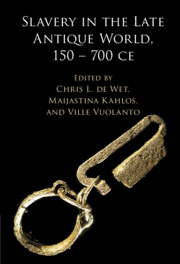Book contents
- Slavery in the Late Antique World, 150–700 CE
- Slavery in the Late Antique World, 150–700 CE
- Copyright page
- Contents
- Figures
- Tables
- Contributors
- Preface
- A Note on Abbreviations and Sources Used
- Introduction Late Antique Studies and the New Polyphony for Slave Studies
- Part I Moral and Symbolic Values of Slavery
- 1 Masters and Slaves in Early Christian Discourse
- 2 Slavery and Religion in Late Antiquity
- 3 (Il)Legal Freedom: Christ as Liberator from Satanic Debt Bondage in Greek Homilies and Hymns of Late Antiquity
- 4 Late Roman Ideas of Ethnicity and Enslavement
- Part II Slavery, Cultural Discourses, and Identity
- Part III Slavery, Social History, and the Papyrological and Epigraphical Sources
- Part IV Social and Religious Histories of Slavery on the Borders of the Empire and Beyond
- Bibliography
- Index
3 - (Il)Legal Freedom: Christ as Liberator from Satanic Debt Bondage in Greek Homilies and Hymns of Late Antiquity
from Part I - Moral and Symbolic Values of Slavery
Published online by Cambridge University Press: 27 January 2022
- Slavery in the Late Antique World, 150–700 CE
- Slavery in the Late Antique World, 150–700 CE
- Copyright page
- Contents
- Figures
- Tables
- Contributors
- Preface
- A Note on Abbreviations and Sources Used
- Introduction Late Antique Studies and the New Polyphony for Slave Studies
- Part I Moral and Symbolic Values of Slavery
- 1 Masters and Slaves in Early Christian Discourse
- 2 Slavery and Religion in Late Antiquity
- 3 (Il)Legal Freedom: Christ as Liberator from Satanic Debt Bondage in Greek Homilies and Hymns of Late Antiquity
- 4 Late Roman Ideas of Ethnicity and Enslavement
- Part II Slavery, Cultural Discourses, and Identity
- Part III Slavery, Social History, and the Papyrological and Epigraphical Sources
- Part IV Social and Religious Histories of Slavery on the Borders of the Empire and Beyond
- Bibliography
- Index
Summary
At some point in the fifth century ce, a series of honorific statues were erected in Stratonikeia, a major city in Caria, Asia Minor. The statues were set up to commemorate the benefactions that one Maximos did for the local community, primarily for the sake of the dispossessed (ἀκτέανοι). While the majority of the inscribed praises that accompanied the statues heaped conventionally generic praise on Maximos for his euergetism, one of the inscriptions gave a rather precise reason for the high esteem that the benefactor enjoyed in the city. When the poor (τῶν πενήτων) of Stratonikeia were hard-pressed to pay the tax of chrysargyron, Maximos stepped in three times and paid the tax on their behalf from his own resources.
The social dynamics reflected in these inscriptions seem emblematic of late antique economic and power relationships between the destitute and their benefactors, as well as the Christian ideology of patronage, earthly and divine, that I discuss below.
- Type
- Chapter
- Information
- Slavery in the Late Antique World, 150 – 700 CE , pp. 66 - 86Publisher: Cambridge University PressPrint publication year: 2022

